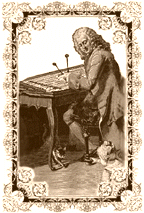|
|
The Piano I have two pianos in my home. One is a small, ordinary spinet, which I call my "utility" piano. It has traveled everywhere with me, and yet it stays remarkably well tuned. The other piano is an antique Mathushek Orchestral Square. We think it was made in 1876. It is about the same size and shape as a pool table, and probably heavier! After being in storage for several years, the poor thing is badly out of tune. It's only function at present is as a catchall for a plethora of bric-a-brac!
The square piano was first produced in the 1760's, when it evolved from the clavichord. By the 1860's, it had developed into the monster that dominates my music room. For a very interesting and informative look at historic pianos, be sure to visitThe Virtual Piano Museum Web site. The 1871 Steinway pictured on the Square Piano page is almost identical to my Mathushek. The Psaltery The ladies pictured in my border illustration appear to be playing psalteries. The psaltery is one of the most ancient forerunners of the piano. It consists of strings stretched across a sounding board. The original psalteries were plucked instruments. At some point in history, (the time period is unclear) the instrument evolved and re-emerged as the bowed psaltery. My first introduction to the bowed psaltery was at a folk festival. As I wandered around through the exhibits, an unfamiliar, ethereal, musical sound drifted through the air. I followed the music and discovered the bowed psaltery. The sound is somewhat similar to that of a thin, almost reedy, violin. I'm still searching for more information and interesting links about the bowed psaltery. Please let me know if you have any helpful information!  and The Kitchen Musician. Used by permission. The Dulcimer The above picture of Bach at the hammered dulcimer was graciously loaned to me by "The Kitchen Musician". Please visit their Hammered Dulcimer Twisted History page for the rest of the story, and a lot more fun "facts" about the history of the hammered dulcimer! The hammered dulcimer was another instrument that I first discovered at a folk festival. Because the group was playing early American music at the time, I naively assumed that the instrument originated in the hills of Appalachia. Wrong! There is, however, a stringed instrument known as the Mountain, or Appalachian dulcimer. It is believed that this instrument did originate in America, but that's another story. The dulcimer is an ancient instrument, which can be found throughout worldwide musical history. Variations of the hammered dulcimer have been known by many names: from the German "Hackbrett", to the Middle Eastern "Santur", the Chinese "Yang Ch'in", and the Hungarian "Cymbalon". See my link to "Mid Eastern Music and the Hammered Dulcimer" for an interesting discussion. Although I have heard everything from Bach to ragtime performed on the hammered dulcimer, the instrument seems to be most frequently used in connection with Celtic or folk music. As a matter of fact, classical music performed on the dulcimer is really hard to find. It is a pity, because the few pieces I have heard were lovely! If anyone knows where I can get a good recording, or MIDI file, of classical music performed on the hammered dulcimer, please let me know! (Sans orchestral background please!) Who knows, perhaps Bach really did practice his counterpoint on the hammered dulcimer. Certainly his predecessors in the Medieval and Renaissance eras would have been familiar with the instrument. Before the invention of the piano, the dulcimer is said to have been a common household instrument. In Conclusion The psaltery and the hammered dulcimer are the direct predecessors of the modern piano, evolving through the harpsichord and the clavichord. Both instruments have re-emerged in modern times. The bowed psaltery is perhaps more of a curiosity, but the hammered dulcimer appears to be gaining in popularity, especially because it is often used in connection with Celtic music. This page was not really intended to be a lesson in music history. Therefore I have omitted specific dates and details. If you want more detailed information, I have tried to provide links to help you. If the background music sounds like any instrument besides piano please click on the button to reset! Links
Medieval and Renaissance Instruments
Chip's Home Page The Kitchen Musicians's Hammered Dulcimers, etc. Mid Eastern Music and the Hammered Dulcimer
Classical MIDI Archives Virtual Piano Museum
This is a site on the Richard Carlson's Piano Page Also a very special THANKS to Silverhair, whose lovely graphic background enhances this page. |







